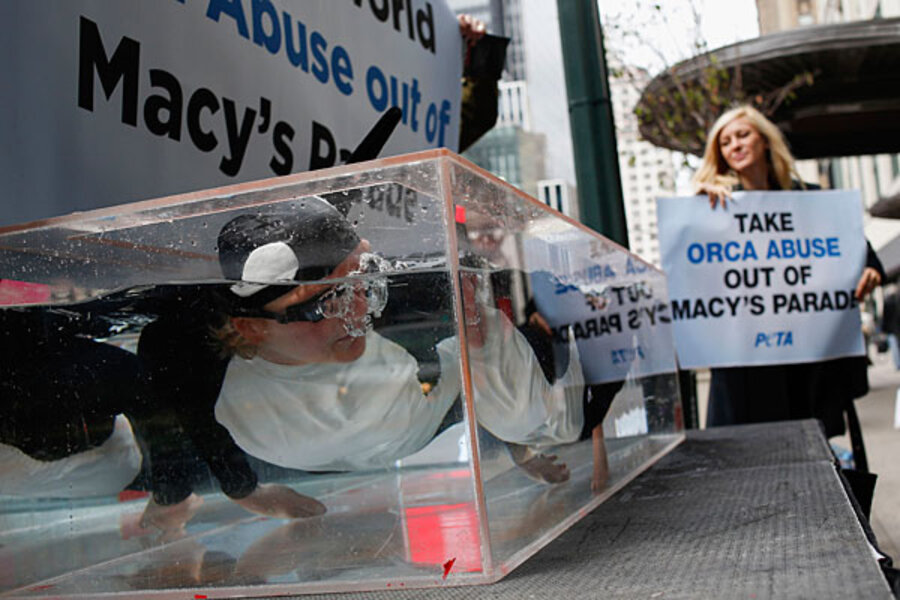SeaWorld float at Macy's Thanksgiving parade stirs animal-rights outrage
Loading...
| New York
The famous floats of New York City’s Macy’s Thanksgiving Day Parade – long the unofficial kickoff of the nation’s holiday season – have been stirring less than holiday cheer this past week.
Nearly 80,000 people have sent letters to parade organizers, urging them to cancel SeaWorld’s “Sea of Surprises” float, which will feature a 27-foot sculpture of “Shamu,” the ocean theme park’s iconic killer whale and signature attraction for millions of visitors each year.
Macy’s officials were also forced to uninvite rock legend Joan Jett last week from performing on South Dakota’s “Mt. Rushmore’s American Pride” float – a response to the state’s cattle ranchers, who raised objections to the artist’s vegetarian lifestyle and support for the animal-rights organization, People for the Ethical Treatment of Animals (PETA).
But the objections to the SeaWorld float – which were also spearheaded by a PETA letter-writing campaign – have stemmed from the recent documentary, "Blackfish," highlighted on CNN in October. The film traces the history of killer whales in captivity and the conditions that led to the killing of SeaWorld trainer Dawn Brancheau in 2010.
For their part, Macy’s organizers have tried to keep out of the ethical debates and keep the focus on entertainment.
“While it is understandable that such a widely embraced event can sometimes feature elements or performances that some people may find disagreeable, Macy's intention is to provide a range of entertaining elements without judgement, endorsement, or agenda,” e-mails Orlando Veras, spokesman for Macy’s. “The Parade has never taken on, promoted or otherwise engaged in social commentary, political debate, or other forms of advocacy, no matter how worthy.”
Activists and some experts find that position upsetting.
“It’s unfortunate that they’re going to have a float to promote what we now know is a very ethically questionable industry,” says Lori Marino, lecturer in neuroscience and behavioral biology at Emory University in Atlanta, who has studied these mammals for more than 20 years. “At this point, everyone knows that this is an issue, and the data and the science on how orcas fare in captivity is pretty unequivocal at this point.”
The lifespan of orcas in captivity is just a fraction of their life expectancy in the wild, which can reach as much as 70 years for some individuals, Ms. Marino says. Only 5 percent of captive orcas make it to age 20, and the mortality rate for infants in captivity is extremely high.
“And when you really think about it, in captivity, they are given food, they have veterinary care, and they should be living longer,” Marino says. “In fact, they die very young. This kind of species has so many needs that are not met in captivity that they experience a tremendous amount of stress, and it eventually affects both their immune system and their will to live.”
“They are so psychologically stressed many of them grate their teeth on the gates between the tanks,” adds Marino, which requires excessive weekly dental work.
SeaWorld has issued strongly worded rebuttals Marino’s research, which was included in “Blackfish.” In a letter, it called the film’s research “egregious and untrue.”
The parade unwittingly stirred up controversy elsewhere, as well. It selected Ms. Jett, the guitarist of “I love Rock ‘n’ Roll” fame, to perform on the South Dakota float after its initial choices were not available. Since livestock products are a significant part of South Dakota’s economy, ranchers felt Jett, a PETA supporter, was not the most appropriate representative for their float, which will be part a Macy’s parade seen by 3 million people on New York streets and an estimated 50 million people on TV.
This in turn brought more attention to the SeaWorld protest.
A three-judge panel of a federal appeals court is currently hearing arguments for SeaWorld’s appeal of a 2010 ruling by US Occupational Safety and Health Administration (OSHA) that fined the theme park $75,000 for exposing its trainers to hazardous environment, issued after Ms. Brancheau’s death.






